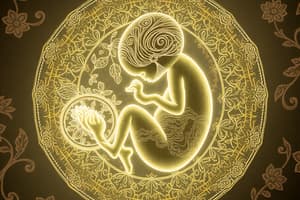Podcast
Questions and Answers
What marks the oocyte-to-embryo transition?
What marks the oocyte-to-embryo transition?
- Release from metaphase I arrest
- Entry into prophase I arrest
- Maturation of the egg cytoplasm
- Formation of a single diploid nucleus from haploid sperm and egg nuclei (correct)
What drives the initial rapid divisions of a developing embryo?
What drives the initial rapid divisions of a developing embryo?
- Paternal stockpile of nutrients
- Maternal stockpile of nutrients, mRNA, and translational machinery (correct)
- Presence of centrosomes from the sperm
- Meiosis-specific proteins from the egg
Which cellular component is brought into the egg by the sperm?
Which cellular component is brought into the egg by the sperm?
- Lysosomes
- Mitochondria
- Ribosomes
- Centrosome (correct)
What regulates the switch from meiosis to mitosis?
What regulates the switch from meiosis to mitosis?
What happens if Matrimony protein is not removed from the early embryo?
What happens if Matrimony protein is not removed from the early embryo?
What triggers the final stages of meiosis in females?
What triggers the final stages of meiosis in females?
What is the main purpose of meiosis in sexually reproducing organisms?
What is the main purpose of meiosis in sexually reproducing organisms?
When does meiosis occur in females?
When does meiosis occur in females?
What triggers the commitment to meiosis (A to A1 transition) in males?
What triggers the commitment to meiosis (A to A1 transition) in males?
What is the main difference between meiosis in males and females?
What is the main difference between meiosis in males and females?
Which stage of the seminiferous epithelium does the A to A1 transition occur in males?
Which stage of the seminiferous epithelium does the A to A1 transition occur in males?
What phase does an oocyte enter following completion of premeiotic S-phase?
What phase does an oocyte enter following completion of premeiotic S-phase?
Flashcards are hidden until you start studying
Study Notes
Meiosis and Development
Meiosis is a type of cell division that occurs in the formation of gametes (sperm and egg cells) in sexually reproducing organisms. In mammals, meiosis is a continuous process throughout the reproductive lifetime, which is ultimately responsible for the production of the massive numbers of gametes required for male fertility. This process is distinct from oogenesis, which occurs at very different times during development and achieves different endpoints. In females, meiosis is initiated in the fetus, with the goal of forming a finite number of stored gametes that are used periodically over a defined reproductive lifetime.
The commitment to Meiosis: A to A1 Transition
In males, the commitment to meiosis, also known as the A to A1 transition, is a critical step in the process of spermatogenesis. This transition is driven by the action of retinoic acid (RA) on the undifferentiated spermatogonia in stages VII to IX of the cycle of the seminiferous epithelium. RA pulses move along the seminiferous tubules, coincident with the spermatogenic wave, and serve as a trigger to commit undifferentiated progenitor cells to the rigidly timed pathway into meiosis.
Meiosis in Oogenesis
In contrast, in females, meiosis is initiated earlier in development. An oocyte enters prophase I following completion of premeiotic S-phase. After homologous chromosome pairs synapse and recombine, the oocyte enters a prolonged prophase I arrest. Oocyte maturation then releases this primary arrest, allowing the oocyte to continue meiosis until its secondary arrest at metaphase I, in what is known as a stage 14 oocyte. Lastly, egg activation triggers resumption and completion of meiosis concordantly with the oocyte-to-embryo transition itself,.
The Oocyte-to-Embryo Transition
Following the successful completion of meiosis, the oocyte-to-embryo transition occurs. This transition is marked by the formation of a single diploid nucleus from the individual haploid sperm and egg nuclei through pronuclear fusion,. The single diploid nucleus must then transition to a mitotic cell cycle within the same cytoplasm in which the meiotic cell division occurred.
Meiosis-Specific Proteins and Structures
The switch from meiosis to mitosis is controlled by cellular proteins and structures produced during gametogenesis. The centrosome, which is important for proper spindle formation during mitotic divisions, is brought into the acentrosomal egg by the sperm. The initial rapid divisions of a developing embryo are driven by the maternal stockpile of nutrients, mRNA, and translational machinery that are "packed" into the egg during oocyte differentiation. Additionally, the egg contains numerous meiosis-specific proteins that are crucial for proper meiotic progression, but are not necessarily needed after the switch to mitosis.
Regulation of Meiotic Progression
Proper cell cycle regulation by the Anaphase Promoting Complex/Cyclosome (APC/C) is crucial in maintaining coordination between meiosis and development. During Drosophila melanogaster oogenesis, Cortex activity is necessary for the degradation of Matrimony, a key regulator of female meiosis in Drosophila. Matrimony inhibits Polo kinase, another important regulator of both mitosis and meiosis that also functions in chromosome segregation, centrosome dynamics, and cytokinesis. When excess Matrimony protein is not removed from the early embryo, developmental defects arise.
Conclusion
Meiosis and development are interconnected processes that are essential for the formation and function of gametes. In males, the commitment to meiosis is driven by retinoic acid pulses, while in females, meiosis is initiated earlier in development and egg activation triggers the final stages of meiosis. The switch from meiosis to mitosis is controlled by cellular proteins and structures produced during gametogenesis, and the regulation of meiotic progression is crucial for the success of both processes.
Studying That Suits You
Use AI to generate personalized quizzes and flashcards to suit your learning preferences.




